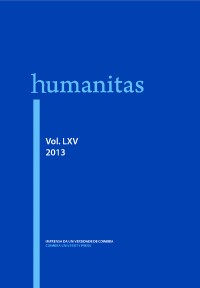Please use this identifier to cite or link to this item:
https://hdl.handle.net/10316.2/27400| DC Field | Value | Language |
|---|---|---|
| dc.contributor.author | Morenilla Talens, Carmen | - |
| dc.contributor.other | Faculdade de Letras da Universidade de Coimbra. Instituto de Estudos Clássicos (ed. lit.) | - |
| dc.date.accessioned | 2013-12-19T14:58:43Z | |
| dc.date.accessioned | 2020-10-02T17:02:49Z | - |
| dc.date.available | 2013-12-19T14:58:43Z | |
| dc.date.available | 2020-10-02T17:02:49Z | - |
| dc.date.issued | 2013 | - |
| dc.identifier.issn | 2183-1718 | - |
| dc.identifier.uri | https://hdl.handle.net/10316.2/27400 | - |
| dc.description.abstract | La sombra de la Antígona de Sófocles ha mediatizado la transmisión e interpretación de las Fenicias de Eurípides. Tres pasajes de Fenicias proyectan en conjunto la imagen de una Antígona muy humana y de una gran entereza de ánimo, próxima al personaje de Sófocles. El primero, la teichoscopía del prólogo; el segundo, una escena central, vv. 1264‑1283, preludio del último estásimo. En el tercero, formado por dos escenas, vv. 1480‑1539 y 1540‑1580, el protagonismo de Antígona es notable y revelador de su carácter. La ausencia del primero, cuya autenticidad ha sido cuestionada, privaría a la Antígona de Fenicias de unos rasgos de carácter que en conjunto hacen de ella un personaje muy humano. | spa |
| dc.description.abstract | Sophocles’ Antigone has influenced the transmission and the interpretation of Euripides’ The Phoenician Women. Three passages of The Phoenician Women have shown us an image of Antigone as quite human and as a brave woman closer to Sophocles’ Antigone. First the teichoskopia of the prologue; second, a central scene, lines 1264‑1283, prelude of the last stasimon; third, made by two scenes, lines 1480‑1539 and 1540‑1580, where the role of Antigone is remarkable and reveals her personality. The absence of the first, whose authenticity has been questioned, would deprive the Antigone shown in The Phoenician Women of some features that, as a whole, configure her character as being quite human. | eng |
| dc.language.iso | spa | - |
| dc.publisher | Imprensa da Universidade de Coimbra | - |
| dc.subject | Antigone | eng |
| dc.subject | Sophocles | eng |
| dc.subject | Euripides’ The Phoenician Women | eng |
| dc.subject | Antígona | por |
| dc.subject | Sófocles | por |
| dc.subject | Fenicias de Eurípides | por |
| dc.title | La Antígona de Fenicias o la larga sombra de la Antígona de Sófocles | por |
| dc.title.alternative | Antigone in Phoinissae or the large shadow of Sophocles' Antigone | por |
| dc.type | article | - |
| uc.publication.collection | Humanitas vol. LXV | - |
| uc.publication.firstPage | 27 | - |
| uc.publication.lastPage | 53 | - |
| uc.publication.location | Coimbra | - |
| uc.publication.journalTitle | Humanitas | - |
| uc.publication.volume | 65 | por |
| dc.identifier.doi | 10.14195/2183-1718_65_2 | - |
| uc.publication.section | Artigos | - |
| uc.publication.orderno | 2 | - |
| uc.publication.area | Artes e Humanidades | - |
| uc.publication.manifest | https://dl.uc.pt/json/iiif/10316.2/27400/257635/manifest?manifest=/json/iiif/10316.2/27400/257635/manifest | - |
| uc.publication.thumbnail | https://dl.uc.pt/retrieve/12003118 | - |
| item.grantfulltext | open | - |
| item.fulltext | With Fulltext | - |
| Appears in Collections: | HVMANITAS | |
Files in This Item:
| File | Description | Size | Format | |
|---|---|---|---|---|
| humanitas65_artigo2.pdf | 338.08 kB | Adobe PDF |  |
Items in DSpace are protected by copyright, with all rights reserved, unless otherwise indicated.
